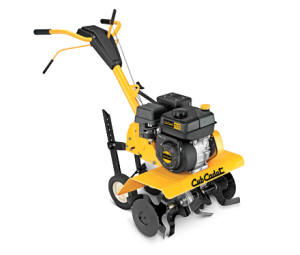 Tilling is an essential part of cultivation. Since tilling land by hand is an arduous and slow process, most property owners and landscape professionals turn to powered equipment to help deposit nutrients into the soil.
Tilling is an essential part of cultivation. Since tilling land by hand is an arduous and slow process, most property owners and landscape professionals turn to powered equipment to help deposit nutrients into the soil.
Cub Cadet offers a range of garden tillers designed to fit any application, ranging from tilling a small garden to larger commercial applications. While different models from Cub Cadet have different features, such as electric starting and different choke systems, most of these tillers operate in a similar fashion.
Safety Precautions
As with any outdoor power equipment, a potential for injury exists if the equipment is improperly used. Before starting any new equipment, be sure to read the owner’s manual in its entirety. Learn all of the controls and the necessary fluid types and dimensions. Do not allow children to operate the machine unsupervised. Never operate the machine in low-light conditions or while under the influence of any substances like alcohol or prescription medication. Remain away from the blades while the machine is powered or capable of being powered.
Turn off the tiller and disconnect the spark plug wire before handling the blades for any reason. If the machine strikes a hard object, inspect the blades. To reduce the possibility of damage from object strikes, remove large rocks, scrap metal, or other tools from the ground before tilling an area.
If anyone other than the operator enters the tilling area, stop the machine until that person leaves. While using a tiller, ensure that you have a firm and flat footing on the ground. Do not force the tiller into the terrain; let the weight of the machine dig into the terrain. Do not twist the tiller while tilling; if the terrain is particularly firm, this can cause the machine to surge forward. If the machine surges out of control, let go of it immediately. Use caution when crossing solid surfaces; attempting to run over brick or concrete walkways is likely to damage the machine and pose a safety hazard.
Operating Essentials
If you have not set the cutting depth, do so before starting the tiller. Remove the spark plug wire and ground it against the engine. If you have never used a tiller before, set the height at one inch, which means inserting the pin into the second hole from the top of the depth stake.
The top position is just a transport position. The second position is used for shallow cultivation and breaking up sod and should be used the first time any land is tilled. Reinsert the spark plug wire when finished with the depth stake.
To start your Cub Cadet tiller, place the gear selector in the neutral position. Either set the throttle control lever to the “fast” position or set the engine speed to “start.” If the engine is cold, prime the choke. Then, pull the starter handle to start the tiller. Once the engine has been started, set the gear lever to an appropriate gear, whether forward or reverse; forward operation is appropriate for tilling soft soil while reverse tine drive is better for harder surfaces. Squeeze the clutch handle to begin moving the machine.
Operating Tips
Tilling will be more effective if the land is tilled twice. Tilling the land repeatedly ensures that the soil is consistently broken up. Generally, the first pass should cut at a shallow depth to break up the top layer and the second pass should cut more deeply into the soil. If the soil is already broken up consistently, use a deeper cutting depth for both passes. To adjust the cutting depth on a Cub Cadet tiller, move the pin to a different position in the depth stake. Each hole in the depth stake represents an increase in two inches of cutting depth; raising the depth stake and inserting the pin into the next hole will increase the cutting depth to three inches. When the bar is at its highest setting, it will be cutting at a depth of seven inches. Ensure that the depth is set properly for your needs.
Where to Buy Replacement Parts
Should you strike a hidden rock or otherwise damage the tines, the tiller may require some unscheduled maintenance. Even a well-maintained machine will require periodic inspections and fluid and parts changes. Use only original equipment when purchasing parts for your Cub Cadet tiller. Aftermarket equipment is not always constructed or designed to the appropriate factory standard. If an aftermarket component damages your tiller, your warranty may be voided. Use CubParts.com when purchasing new components. The site carries a full array of factory original replacement parts, which users can locate by inputting their model number and viewing extensive machine diagrams. This prevents compatibility issues from arising and ensures that owners get the right part for the right machine.
